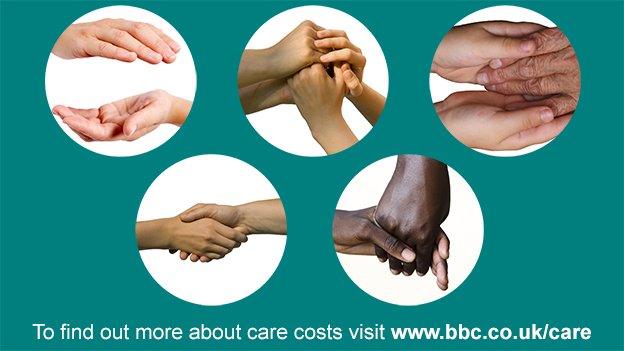Does the (care) cap fit?
- Published

There are three main dictionary definitions of a cap: a soft, flat hat, a protective cover or lid and an upper limit on spending or borrowing. The cap on care costs for the over 65s is, arguably, none of these.
The first two are, of course, obvious. But the third? Let me explain why.
Unlike the NHS, people have to pay for the care provided in care homes or with daily tasks at home, such as washing and dressing. Only the poorest get some help towards their costs currently.
From April 2016 the government is capping care costs after the age of 65 at £72,000 over the rest of a person's life. However, there are three important caveats to this.
First, you have to get into the system. Only when an individual is deemed to be eligible for care does their spending count towards the cap. But access is rationed to people with high care needs.
Struggling
There is a complex definition of what this means, but essentially it is when a person is really struggling with daily tasks such as washing, dressing and eating.
Most people in care homes will obviously qualify, but that is not the case for people who are just about getting by at home.
More than 4m people aged 65 and over - about one in two - have what could be classed as a care need, according to the charity Independent Age. For half, it will be pretty low level.
But of the remaining 2m, only between 500,000 and 1m older people - the estimates suggest - would qualify for help in the new system.
It means there will be an awful lot of people paying for care or relying on friends and family who are not even classed as being "in the system". Any expenses they incur will not even count towards the cap.

How the cap is changing the system

People have to pay for their care whether that's round-the-clock help in a care home or support with tasks such as washing and dressing in their own home.
Currently only those with low means - under £23,250 in savings and, in some cases, the value of a home - get help towards their costs.
The rest have to pay all their care costs. For one in 10 these can exceed £100,000.
From 2016, for the first time ever, care costs will be capped at £72,000 from the age of 65 onwards. Those with low means will get help at an earlier point.
The average cost of a care home place in England is £574 a week, but £230 of everyone's fees does not go towards the cap as it is for living costs, such as food and accommodation.
While councils only have to help the poorest with the bills up until they cap, there is a duty on them to provide information about the care system to anyone who asks.

The second caveat relates to the costs people face when moving into a care home, which tends to be the really expensive end of the care system.
Even when an individual is deemed to be eligible, £230 of the weekly fee doesn't count towards the cap. That is because it is earmarked for living costs, such as the room, heating and food.
That - many people say - is understandable as such costs would be incurred if an individual was living in their own home (although arguably they would not be as high as that in some places). What is more, these living costs still have to be paid after the cap is reached too.
'Hidden extra'
The third caveat - lets call it a hidden extra - is the fact that an individual's bill only racks up at the rate a council would pay for a place in the care home.
But many care home providers say this does not cover the true cost of care so they charge people funding themselves more. Sometimes these fees can be twice as high.
The last two factors explain why by the time a person reaches the cap they may have paid much, much more than the £72,000 it is set at.
For example, say an individual is charged £1,000 for a care home place, but the council has negotiated a rate of £730 for the people it places (those people with low means who get help before they reach the cap), only £500 (£730 - £230 living costs) of the individual's weekly bill will count towards their cap.
It means they will have paid out £144,000 by the time they reach the £72,000 figure.
England care market
£72,000
cap on care costs starts in 2016
-
850,000 already get get council help at home or in care home
-
700,000 pay for their care
-
420,000 live in care homes
-
1.5m rely on family and friends for support
Ministers say that those paying for themselves can get the council to negotiate their price, but at the moment there is no guarantee that will work.
It means those who do reach the cap could find themselves paying significant sums in extra charges (daily living costs + the top-ups) even when the state steps in.
The government, when pressed, accepts these points. But it argues that the system is better than what is currently in place where anybody with moderate wealth can face pretty much unlimited costs.
That maybe true, but it hasn't stopped some people questioning how the new policy is being described. James Lloyd, from the Strategic Society think-tank, is one. "Few people will experience is as a cap," he says. "It will be much more like a co-payment."
But - and this the real string in the tail - even as a co-payment there will only be very few people who benefit. Government estimates put it at about one in eight people. Why so few?
The average length of stay in a care home is just over two years. Yet in many parts of the country it will take longer than that to reach the cap. In short, most people will be dead before the state helps out.

BBC cost of care project

